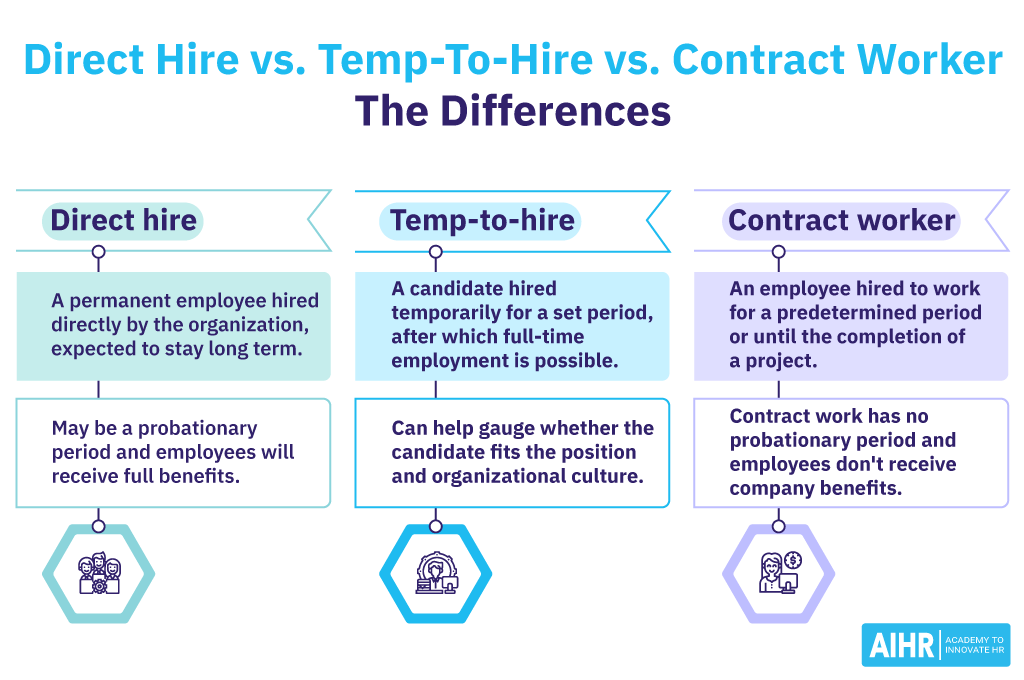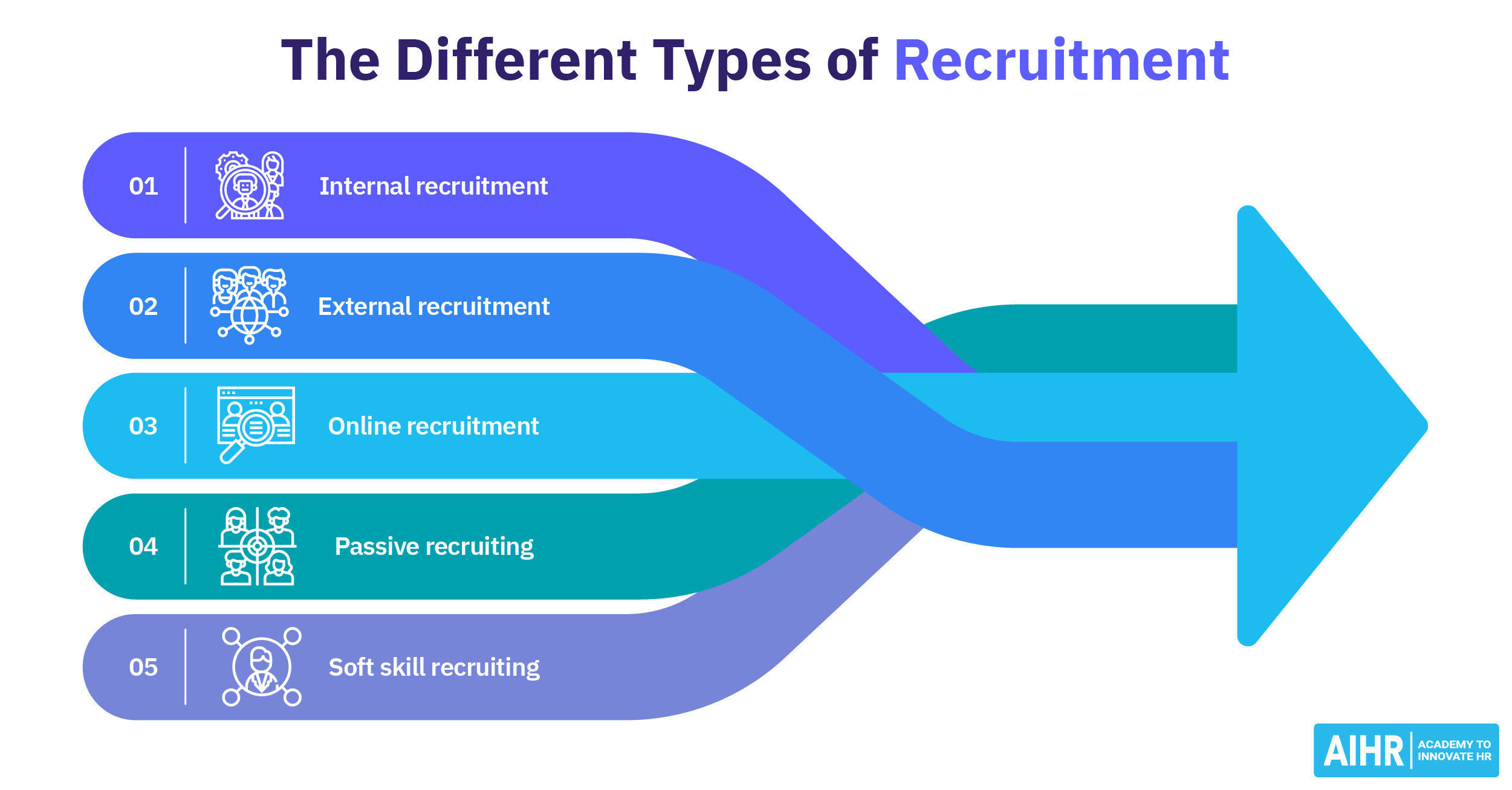Direct Hire
What is a direct hire?
Direct hires are employees hired directly by an organization for permanent positions. This means no staffing agencies or recruiters are involved and no contractual terms.
The organization handles the entire hiring process, from sourcing candidates to conducting interviews and making job offers. Once candidates accept the offer, they become part of the organization’s payroll and benefits system.
Direct hire vs. temp-to-hire vs. contract worker
- Direct hire: This involves hiring an employee who is expected to remain with the organization for the long term. While there might be an initial probationary period, the employee receives full benefits like healthcare and retirement plans.
- Temp-to-hire: A candidate you hire temporarily for a set period, after which full-time employment is possible. This approach is ideal as it can help gauge whether the candidate fits the position and organizational culture.
- Contract worker: An employee you hire to work for a predetermined period or until the completion of a project. Contract work has no probationary period, as the engagement has a fixed end date. They are temporary employees and don’t receive company benefits.

Benefits of direct hiring for employers
Direct hiring offers several benefits for employers, including:
- Reduced employee turnover due to long-term commitment
- Assessment of cultural fit
- Potential for long-term growth
- Improved quality of hires
- Enhanced employee engagement, productivity, and loyalty
- Access to specific skills and expertise beneficial to the business
- Opportunity to attract high-quality candidates who might not actively seek temporary positions
- Improved performance evaluation.
Challenges in direct hiring for HR
While direct hiring has advantages, it also presents challenges, such as:
- Time-consuming processes can lead to delayed onboarding and filling of critical positions promptly
- Higher recruitment costs
- Limited flexibility compared to temporary or contract hiring
- Competition and counteroffers from other employers
- Increased risks related to cultural misfits, bias, discrimination, bad hires, and legal compliance issues
- Lack of a trial period or do-over inherent in direct hiring
- Limited access to modern hiring tools and technology, potentially slowing down recruitment.
The direct hire process
Direct hiring can be complex, daunting, and time-consuming. Leverage the following steps:
| 1. Job analysis and description | Understanding the position you want to fill will help you create a detailed and accurate job description that outlines the job’s duties and expectations. Identify the key responsibilities, required skills, qualifications, and experience for the role. Include the remuneration as it’s among the most crucial part, motivating over 90% of them to apply for the post. |
| 2. Sourcing and recruiting | With the job description in hand, the next step is to source and recruit candidates actively. This involves utilizing various channels like online job boards, social media platforms, industry networks, employee referrals, and professional associations. Casting a wide net increases the likelihood of finding qualified candidates suited for the position. |
| 3. Screening and selection | As applications come in, your HR team will screen resumes and applications to assess candidates’ qualifications, experience, and skills in relation to the job requirements. The selection process then narrows the candidate pool to the most qualified individuals. |
| 4. Interview and assessment | Shortlisted candidates undergo interviews conducted by the HR team. These interviews can occur in person, over the phone, or virtually. The aim is to assess candidates’ skills, experience, and alignment with the job requirements and company culture. Structured interviews focused on the job’s demands are crucial. |
| 5. Reference and background check | After interviews are completed, conducting reference and background checks is essential. This step involves contacting the candidates’ references to verify work history, performance, and character. Background checks ensure the accuracy of provided information and identify any potential issues. |
| 6. Offer and negotiation | If a candidate passes all the evaluations, the HR team extends a job offer that includes details such as the job title, compensation, benefits, start date, and other relevant information. There may be negotiations to reach a mutually agreeable arrangement. |
| 7. Onboarding | Once the candidate accepts the offer, a structured onboarding process helps integrate them smoothly into the organization. Orientation, training, and access to organizational policies and procedures are provided to ensure a productive work experience and enhance the chances of the employee’s long-term success. |
Tips for HR on direct hiring
Direct hiring can effectively attract top talent, reduce recruitment costs, and maintain added control over the hiring process. To help you achieve this goal:
- Craft clear, concise, and detailed job descriptions
- Streamline the process using technology like Applicant Tracking Systems, online background check services, and Video Interviewing Software
- Utilize diverse sourcing channels, including social media, online job boards, industry networks, professional associations, and employee referrals
- Implement efficient screening methods, such as phone interviews, assessments, on-site interviews, video interviews, reference and background checks, and job trials
- Ensure a structured onboarding process
- Provide candidates with timely and constructive feedback.







